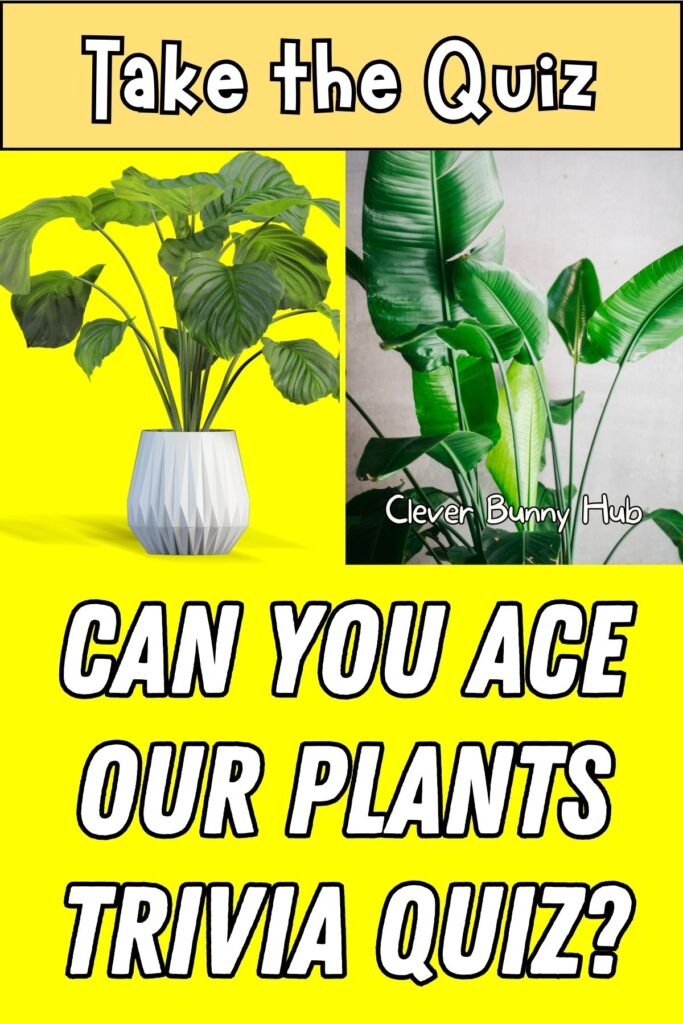Welcome to the captivating world of flora! Get ready to embark on a journey through the fascinating realm of plants with our Plants Trivia Quiz. Whether you’re a seasoned botanist, an avid gardener, or simply someone with a curious green thumb, this quiz is designed to challenge and delight your plant knowledge.
From the tiniest mosses to towering trees, and from the depths of the rainforest to your backyard garden, our trivia quiz covers a diverse range of plant-related topics. Test your understanding of plant anatomy, explore the secrets of photosynthesis, and uncover the unique characteristics of various plant species.
So, whether you’re passionate about horticulture, interested in environmental science, or just eager to learn more about the incredible world of plants, join us in this botanical adventure. Challenge yourself, discover new facts, and see if you can emerge as the ultimate Plants Trivia Master! Let the quiz begin, and may your botanical brilliance shine!
1. What is the process through which plants convert sunlight into food?
A. Photosynthesis
B. Respiration
C. Transpiration
D. Osmosis
2. Which part of the plant conducts water and nutrients from the roots to other parts?
A. Leaves
B. Xylem
C. Flowers
D. Roots
3. Which of the following is a flowering plant with nectar-producing glands?
A. Carnivorous plant
B. Epiphyte
C. Deciduous plant
D. Nectar plant
The primary purpose of nectar is to attract pollinators. The sweet taste of nectar serves as an incentive for pollinators to visit flowers, ensuring the transfer of pollen between plants.
4. What is the male reproductive part of the flower called?
A. Stamen
B. Pistil
C. Sepal
D. Petal
5. What is the process through which plants release excess water vapor?
A. Transpiration
B. Photosynthesis
C. Respiration
D. Diffusion
Transpiration serves as a cooling mechanism for plants. As water evaporates from the surface of leaves, it absorbs heat, providing a cooling effect similar to sweating in animals.
6. What is the main purpose of the roots in a plant?
A. To carry out photosynthesis
B. To produce flowers
C. To take in water and nutrients
D. To provide support to the plant
7. Which of the following is not a part of a plant’s reproductive system?
A. Stamen
B. Pistil
C. Sepal
D. Ovary
8. Which of the following is a plant hormone responsible for promoting cell elongation?
A. Cytokinin
B. Auxin
C. Gibberellin
D. Ethylene
9. What is the pigment responsible for giving plants their green color?
A. Chlorophyll
B. Carotenoid
C. Anthocyanin
D. Xanthophyll
Chlorophyll gives plants their characteristic green hue by absorbing light in the blue and red regions of the electromagnetic spectrum and reflecting green light.
There are several types of chlorophyll, with chlorophyll-a and chlorophyll-b being the most common in higher plants. Each type has a specific role in capturing light during different stages of photosynthesis.
10. Which part of a plant’s flower contains the female reproductive organs?
A. Stamen
B. Pistil
C. Sepal
D. Petal
11. During the process of pollination, what is transferred from the stamen to the pistil?
A. Pollen
B. Nectar
C. Water
D. Oxygen
The stamen consists of an anther, which produces pollen. The pollen contains the male reproductive cells necessary for fertilizing the ovules within the ovary of the pistil.
12. What is the protective outer layer of a plant called?
A. Epidermis
B. Cuticle
C. Cortex
D. Pith
13. How do plants acquire carbon dioxide for photosynthesis?
A. Through their roots
B. Through their stems
C. Through their leaves
D. Through their flowers
14. What is the main function of flowers in a plant?
A. To produce seeds
B. To store water
C. To capture sunlight
D. To carry out sexual reproduction
Flowers have cultural and symbolic significance in many societies. They are often associated with expressions of love, celebration, and remembrance and are used in various ceremonies and traditions.
Flowers contribute significantly to the global economy through the production of fruits, vegetables, nuts, and other agricultural products. Many crops crucial for human consumption rely on successful flower pollination for their yield.
15. Which of the following is a flowering plant that completes its life cycle within one year?
A. Perennial
B. Biennial
C. Annual
D. Deciduous
16. What is the process by which plants produce new offspring without the need for seeds?
A. Asexual propagation
B. Sexual reproduction
C. Fertilization
D. Germination
17. What is the function of the plant’s stomata?
A. To absorb sunlight
B. To release oxygen
C. To exchange gases
D. To store water
18. Which of the following is a parasitic plant that obtains nutrients from other plants?
A. Cuscuta
B. Orchid
C. Venus flytrap
D. Dodder
19. What is the outermost layer of a tree trunk called?
A. Pith
B. Bark
C. Xylem
D. Phloem
20. Which of the following is a plant hormone responsible for promoting fruit ripening?
A. Gibberellin
B. Cytokinin
C. Ethylene
D. Auxin
21. How do plants reproduce sexually?
A. By producing seeds
B. By producing spores
C. Through the process called pollen grain
D. Through a process called pollination
22. Which part of the plant contains the embryo and serves as a protective covering for the seed?
A. Seed coat
B. Endosperm
C. Embryonic axis
D. Radicle
23. What is the process of shedding leaves during a particular season called?
A. Germination
B. Photosynthesis
C. Abscission
D. Defoliation
24. In what process do plants convert glucose into energy in the absence of sunlight?
A. Germination
B. Photosynthesis
C. Transpiration
D. Glycolysis
25. Which plant hormone is responsible for promoting cell elongation and growth?
A. Gibberellin
B. Abscisic acid
C. Auxin
D. Cytokinin

There’s more room for improvement!
Everyone starts somewhere, and this is an opportunity to begin your journey into the fascinating world of plants. The important thing is the willingness to learn and explore.
Take this as a chance to delve into the wonders of flora, discover the unique characteristics of different plants, and understand their vital roles in our ecosystem. Whether you’re a beginner or just looking to brush up on your botanical knowledge, there’s always room for growth.

Fantastic job!
Your performance demonstrates a strong grasp of botanical knowledge, showcasing a keen interest in the world of plants. You possess a solid foundation in plant-related facts, from their anatomy to ecological functions.

Congratulations on achieving a perfect score!
You’re undoubtedly a true green enthusiast with an impressive command of botanical knowledge. Your ability to navigate through the diverse world of plants, from their anatomy to ecological roles, is truly commendable.
Related Posts






























